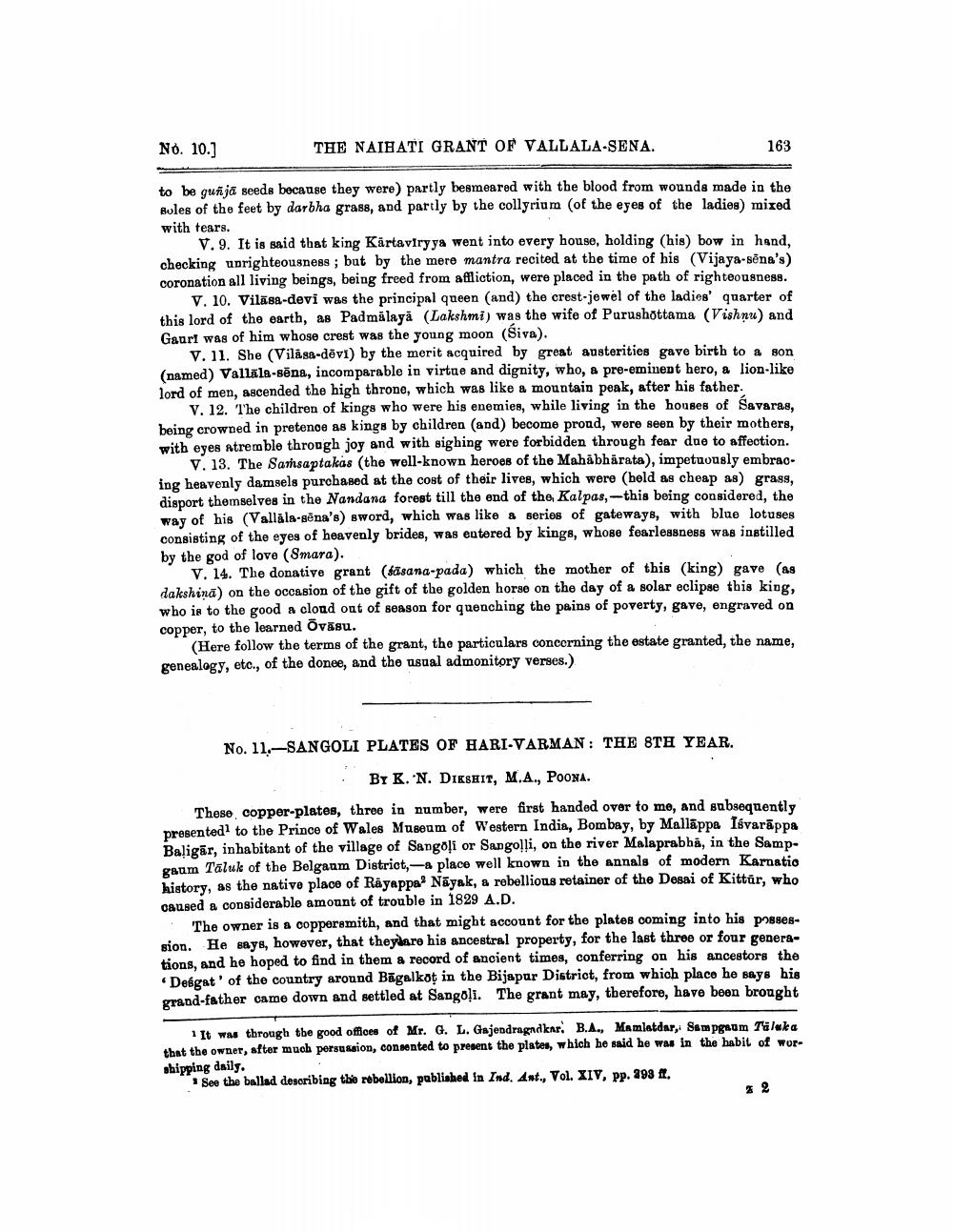________________
No. 10.]
THE NAIRATI GRANT OF VALLALA-SENA.
163
to be guñja seeds because they were) partly besmeared with the blood from wounds made in the Bules of the feet by darbha grass, and partly by the collyrium (of the eyes of the ladies) mixed with tears.
V. 9. It is said that king Kärtaviryya went into every house, holding (his) bow in hand, checking uprighteousness; but by the mere mantra recited at the time of his (Vijaya-sēna's) coronation all living beings, being freed from afiliction, were placed in the path of righteousness.
V. 10. Vilisa-devi was the principal queen (and) the crest-jewel of the ladies' quarter of this lord of the earth, as Padmalayă (Lakshmi) was the wife of Purushottama (Vishnu) and Gauri was of him whose crest was the young moon (Siva).
v. 11. She (Vilasa-dovi) by the merit acquired by great austerities gave birth to a son (named) Vallála-sēna, incomparable in virtue and dignity, who, a pre-eminent hero, a lion-like lord of men, ascended the high throne, which was like a mountain peak, after his father.
v. 12. The children of kings who were his enemies, while living in the houses of Savaras, being crowned in pretence as kings by children (and) become proud, were seen by their mothers, with eyes atremble through joy and with sighing were forbidden through fear due to affection.
V. 13. The Sansaptakas (the well-known heroes of the Mahabharata), impetuously embracing heavenly damsels purchased at the cost of their lives, which were (held as cheap as) grass, disport themselves in the Nandana forest till the end of the Kalpas,-this being considered, the way of his (Vallala-sēna's) sword, which was like a series of gateways, with blue lotuses consisting of the eyes of heavenly brides, was entered by kings, whose fearlessness was instilled by the god of love (Smara).
V. 14. The donative grant (fasana-pada) which the mother of this (king) gave (as dakshina) on the occasion of the gift of the golden horse on the day of a solar eclipse this king, who is to the good a cload out of season for quenching the pains of poverty, gave, engraved on copper, to the learned Ovisu.
(Here follow the terms of the grant, the particulars concerning the estate granted, the name, genealogy, etc., of the donce, and the usual admonitory verses.)
No. 11,--SANGOLI PLATES OF HARI-VARMAN: THE 8TH YEAR.
• BI K.'N. DIKSHIT, M.A., POONA. These copper-plates, three in number, were first handed over to me, and subsequently presented to the Prince of Wales Museum of Western India, Bombay, by Mallāppa Isvarāppa Baligār, inhabitant of the village of Sangoļi or Sangolli, on the river Malaprabha, in the Sampgaum Taluk of the Belgaum District,-a place well known in the annals of modern Karnatio history, as the native place of Rayappa Nayak, a rebellious retainer of the Dosai of Kittär, who caused a considerable amount of trouble in 1829 A.D.
The owner is & coppersmith, and that might account for the plates coming into his p788€6sion. He says, however, that they are his ancestral property, for the last three or four generations, and he hoped to find in them a record of ancient times, conferring on his ancestors the
Delgat' of the country around Bagalkot in the Bijapur District, from which place he says his grand-father came down and settled at Sangoļi. The grant may, therefore, have been brought
1 It was through the good offices of Mr. G. L. Gajendragndkar. B.A., Mamlatdar, Sampgaum Tülaka that the owner, after much persuasion, consented to present the plates, which he said he was in the habit of worshipping daily.
See the ballad describing the rebellion, published in Ind. Ant., Vol. XIV, pp. 293 ft.




